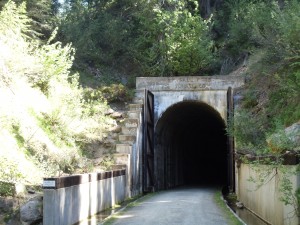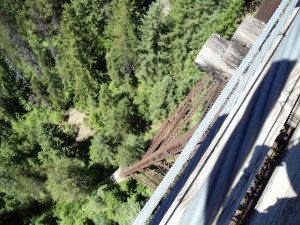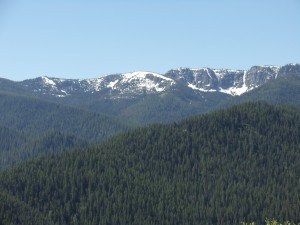It’s called the “Route of The Hiawatha,” after the legendary luxury train that rolled from the Idaho mountains to the Midwest in the first half of the Twentieth-Century, on the Chicago, Milwaukee and St. Paul Railroad.
The last train on this stretch of railroad left the station in 1961. But “The Milwaukee Line” left us a living legacy – some 46 miles of railroad track/bed running through the 8,000-foot peaks of the Bitterroot Mountains on the Idaho-Montana border.
The first third of that stretch has been turned into a mountain-bike route. Fifteen miles, through old, abandoned railroad tunnels, some as long as two miles, and all of them pitch-black, with big potholes and water dripping from cracks in the sides.
You first come to understand the reality of what you’re about to attempt as you stand with your bike at the entrance to the trail, which happens to be the site of the first tunnel – the longest, at nearly two miles. (It’s also called the St. Paul Pass, or, more commonly, “The Big Tunnel.”) In front of you lies a crumbling entrance to a hundred-year-old tunnel in a huge mountain. And the blackest and deepest hole you’ve ever seen.

Yes, your helmet does have a head-lamp (which doesn’t do all that much good, I’m afraid). And staying balanced – even staying upright – can be tricky. For one thing, there’s that dripping water seeping into the old railroad bed. There are potholes the size of…well, Montana. There are chunks of rock you can’t see. And there are the steely remnants of the tracks, disappearing in and out of the gravel and black mud and water and potholes. (I didn’t see any bats, though, who are inhabitants of many of the old railroad tunnels I’ve explored elsewhere.)
When you do finally see the light at the end of the tunnel, it’s almost as if your eyes are playing tricks on you…because you can pedal for minutes, and the light still doesn’t seem to be getting any closer. In fact, the light doesn’t seem to get any bigger until you’re practically upon it.
Midway through The Big Tunnel – you’ve got to keep your eyes peeled – you’ll come to a small sign on the wall marking the Idaho-Montana border. Which – for a split-second, anyway – affords you the opportunity to be mountain-biking in two states at the same time.

As you cycle along the railroad bed, you’ll come in and out of tunnels (nine of them) blasted through mountain and rock, at great cost in human life. You’ll cross over 1,000-foot-high, creaky wooden trestles (seven of them), offering extraordinary vistas of forest and snow-capped mountains all around you, and rushing streams and elk below you. Your world seems to alternate between brilliant sunshine and blue skies and green mountains, and then pitch-blackness.
You’ll pass – even in summer – patches of snow. And you’ll breathe perhaps the freshest air you’ve ever breathed.
You may see a bear. You may see elk or moose. You may see deer. And you may even see – I hesitate to add the phrase, “if you’re lucky” – a mountain lion (called a cougar in these parts).
No one knows exactly how many men died creating these tunnels for the “Milwaukee Road.” But the figure was no doubt substantial. There were horrific accidents, and cave-ins, and landslides. There was acrid smoke and horrible smells in the tunnels. There were wild animals all over the place. And, because of the unsanitary conditions, disease felled many a hardy man.

And there are poignant stories, as well. Perhaps the most touching took place during August 19-21, 1910, when the largest forest fire in American history lit up 3,000,000 acres of Idaho and Montana. “The Milwaukee” was still under construction, and hundreds of workers and their families were evacuated by train, through flames and hurricane-force winds that sucked the oxygen out of the air and turned everything into a giant furnace.
One of the workers on the evacuation train panicked, and jumped off. Everyone else on that train somehow survived the fire. But he didn’t. And the spot where the flames got this nameless worker is marked by a wooden cross on the side of the tracks.
Today the Route of the Hiawatha is part of the national “Rails to Trails” program – in some peoples’ opinion, the most spectacular part of the Rails to Trails program. It’s a thrilling, exhilarating, incredible journey through a dizzying world of colors and blackness and sensations and experiences.
The people who can outfit you and guide you through the Route of the Hiawatha – and who have a hundred fascinating stories about the history, geology, and wildlife of the area – are at Lookout Pass Ski & Recreation Area. (And they’re also the folks who can put you on skis, and ski runs, in Lookout Pass in winter.)
The jump-off point for The Route of the Hiawatha is the Idaho-Panhandle town of Coeur D’Alene. It’s an authentic far-Northwestern town, with gas-lit street lamps, old red-brick buildings housing interesting bistros and bars, and galleries.
The town sits on Lake Coeur D’Alene, an ice-blue alpine lake surrounded by 125 miles of mountainous, forested shoreline.
Lake Coeur D’Alene is one of America’s great kayaking spots. Overhead, bald eagles soar over the water in search of the evening meal they’ll bring back to their families nesting nearby. The only sound you’ll hear is your oar lapping the water. The only boat you’ll see is probably your own. And the only emotion you’ll feel is awe.
The best place to stay in town is the wonderful Coeur D’Alene Resort, at the foot of the lake, with 340 newly-renovated, luxurious rooms (many with incredible views), three excellent restaurants, a golf course accessed by boat (with the world’s only floating hole), a Western art gallery, a lake-cruise boat, and its own float-plane.
Last word? If you take a mountain bike through the Route of the Hiawatha, be prepared to hit the tunnel walls a few times. And be prepared to love every minute of it!
Resources:
Route of the Hiawatha
(208) 744-1301
www.ridethehiawatha.com
Lookout Pass Ski & Recreation Area
(208) 744-1301
www.skilookout.com
Coeur D’Alene Resort
(208) 765-4000
www.cdaresort.com


